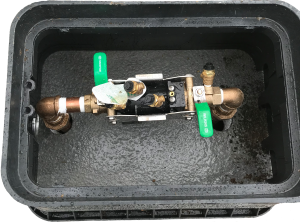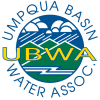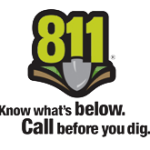The Backflow Program
Backflow is the undesirable reversal of flow of a consumer’s potable water system and/or non-potable water or other substance into the public water system.
Why the concern about Cross-Connection and Backflow Prevention?
Only through cross-connection controls and backflow prevention can we be assured that other sources are not contaminating the public water system. Backflow prevention assemblies, devices and/or methods are utilized on water supply piping to protect against hazards caused by back pressure or backsiphonage conditions that could cause pollutants or contaminants to backflow into the public water supply and/or the water user’s system.
The State Of Oregon and the EPA have stated that a Cross Connection Control Program will be in place to protect the public water system. The Cross Connection Control Rules (in PDF format) can be viewed by clicking on the words Cross Connection. You can also download the EPA Cross Connection Control manual by visiting the EPA web site at: http://www.epa.gov/safewater/crossconnection.html
You can also visit the State of Oregon web site for Cross Connection at:http://oregon.gov/DHS/ph/crossconnection/index.shtml.
Any connection between a public water system and a consumer’s potable water system and or non-potable water or other substance. An example is the public water system and a homeowner’s landscape irrigation system, river irrigation, ponds, out door faucets, swimming pool, hot tub, water trough, well or storage tank.
Plumbing cross-connections, which are defined as actual or potential connections between a potable and non-potable water supply, constitute a serious public health hazard. There are numerous, well-documented cases where cross-connections have been responsible for contamination of drinking water, and have resulted in the spread of disease. The problem is a dynamic one, because piping systems are continually being installed, altered, or extended.Control of cross-connections is possible, but only through thorough knowledge and vigilance.
The easiest way to verify if a device such as described above is needed for your home/business is to email or call our office and make an appointment for our Cross Connection Specialist to perform a site evaluation of your plumbing layout.
Yes there are but this all depends on your specific application. The list includes the four general types of testable backflow prevention assemblies;
- Double Check valve backflow prevention assemblies (DC), and the related
Double Check-Detector backflow prevention Assemblies (DCDA), - Reduced Pressure principle backflow prevention assemblies (RP) and the
related Reduced Pressure principle-Detector backflow prevention
Assemblies (RPDA), - Pressure Vacuum Breaker backsiphonage prevention assemblies (PVB),
- Spill resistant pressure Vacuum Breaker backsiphonage prevention
assemblies (SVB).
Non-testable backflow prevention devices such as Atmospheric Vacuum Breakers (AVB) are approved under Oregon Plumbing Specialty Code as listed with the ASSE Seal Program. The American Society of Sanitary Engineering (ASSE) Seal Program lists approved manufacturers and uses, for example, the standard designation of 1001 for pipe applied AVB (example: irrigation systems) and 1011 for hose-type connection AVB.
An approved air gap is a method of backflow prevention that means the physical separation between the end of the water supply pipe (example: faucet) and an open vessel (example: sink). Approved air gaps are generally at least twice the diameter of the supply piping, in no case less than 1 inch (2.54 cm) and are in accord with Oregon Plumbing Specialty Code.
All of the devices installed on the UBWA system have to meet or exceed the State of Oregon and UBWA requirements. This includes the type of device, size of device, how the devices are installed, how they are tested and how they are protected. For the specifics for the most common devices installed on our system, we have posted those here on our website. For the information on a Reduced Pressure Backflow Device, click HERE. For the information on a Double Check Backflow Device, Click HERE. If you have questions, are unable to reach the link for any of the instructions, or the device you have is not one of those listed here, please call our office during normal business hours. l
After the device has been properly installed, you will need to have the device tested by a State of Oregon Certified Backflow Tester. You can contact our office for a list of State of Oregon Certified Backflow Testers. Do not forget to insulate the device from freezing. Once the test is complete, a record of that test is required to be filed with the Umpqua Basin Water. It is required by law to have the Backflow device tested on an annual basis. If the device is not tested by the annual date, the water service to the residence or business will have the water service disconnected until the test has been successfully performed. Generally, you will receive a letter from us reminding you of this test date. If there are any other questions you might have regarding Backflow Devices, please do not hesitate in contacting our office.
As a water supplier Umpqua Basin Water is responsible for protection of the potable water supply. Umpqua Basin Water’s Cross Connection program has put in place a Backflow Assembly Tester (BAT) Standard for all state certified backflow assembly testers testing assemblies within our water district.
The BAT Standards have been put into place in an effort to create a general standard for all testers that perform tests within our water district, and to assure UBWA’s Cross Connection Specialists, that UBWA and OHA testing regulations are met or exceeded by all testers.
The BAT Standards must be signed and returned to our office in order for any test to be accepted and tester or company to be able to test within the UBWA service area. If a company has more than one tester, each tester must sign and agree to the terms of the BAT Standards.
UBWA reserves the right to refuse a test report from a tester that has not signed the BAT Standards. After the initial BAT standards are signed, all testers will be required to renew the BAT Standards every January 1.
You can also download the BAT Standards here.
Backflow Device




